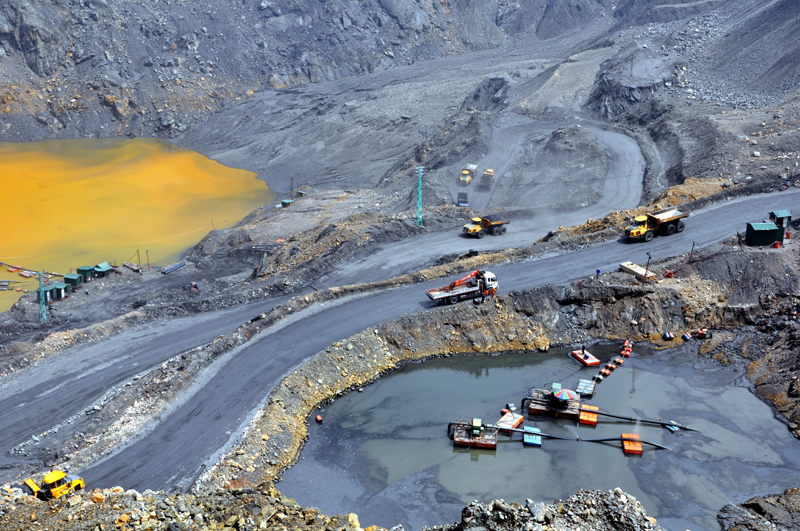Vietnam: Regulations on the categorization of iron ore mines to be extracted
Recently, the Ministry of Natural Resources and Environment issued Circular 33/2010/TT-BTNMT on exploration, classification of reserves, and resources of iron ore mines, including the categorization of iron ore mines to be extracted in Vietnam.

Vietnam: Regulations on the categorization of iron ore mines to be extracted (Illustrative image)
Circular 33/2010/TT-BTNMT stipulates the categorization of iron ore mines to be extracted in Vietnam as follows:
1. Basis for categorization of iron ore mines to be extracted in Vietnam
- Pursuant to the shape, size of the iron ore body, complexity of the mine's geological structure, stability of thickness, quality, and internal structure of the iron ore body.
- Pursuant to quantitative indices on the variation of conditions for dividing the groups.
- Pursuant to specific argumentation and evaluation of the iron ore body in the main area, occupying not less than 70% of the mine's reserves.
2. Categorization of iron ore mines to be extracted in Vietnam
- Simple Group (I)
- Complex Group (II)
- Very Complex Group (III).
3. Conditions for categorization of iron ore mines to be extracted in Vietnam
- Simple Group (I): Includes mines or areas with a simple geological structure with horizontal or gently dipping ore bodies, a product ore coefficient greater than 0.8, and a simple shape, a perimeter variation coefficient less than 1.4; stable thickness, thickness variation coefficient not greater than 40%; the main useful and harmful component contents are evenly distributed, content variation coefficient not greater than 40%.
- Complex Group (II): Includes mines or areas with a complex geological structure with ore bodies in the form of large veins or lenses; lens forms, nesting, columnar, or tube-like forms; product ore coefficient varying from 0.6 to 0.8, complex shape; perimeter variation coefficient ranging from 1.4 to 1.8; unstable thickness, thickness variation coefficient ranging from over 40% to 100%; the main useful and harmful component contents are unevenly distributed, content variation coefficient ranging from over 40% to 100%.
- Very Complex Group (III): Includes mines or areas with a very complex geological structure with small to medium-sized ore bodies in the lens, seam-column form, product ore coefficient below 0.6, and very complex shape, a perimeter variation coefficient greater than 1.8; very unstable thickness, thickness variation coefficient over 100%; the main useful and harmful component contents vary very unevenly, content variation coefficient over 100%.
More details can be found in Circular 33/2010/TT-BTNMT effective from January 28, 2011.
Nguyen Phu
- Number of deputy directors of departments in Vietnam in accordance with Decree 45/2025/ND-CP
- Cases ineligible for pardon in Vietnam in 2025
- Decree 50/2025 amending Decree 151/2017 on the management of public assets in Vietnam
- Circular 07/2025 amending Circular 02/2022 on the Law on Environmental Protection in Vietnam
- Adjustment to the organizational structure of the Ministry of Health of Vietnam: Certain agencies are no longer listed in the organizational structure
- Vietnam aims to welcome 22-23 million international tourists in Vietnam in 2025
-

- Number of deputy directors of departments in Vietnam ...
- 15:04, 05/03/2025
-

- Cases ineligible for pardon in Vietnam in 2025
- 14:43, 05/03/2025
-

- Decree 50/2025 amending Decree 151/2017 on the ...
- 12:00, 05/03/2025
-

- Circular 07/2025 amending Circular 02/2022 on ...
- 11:30, 05/03/2025
-

- Adjustment to the organizational structure of ...
- 10:34, 05/03/2025
-

- Notable new policies of Vietnam effective as of ...
- 16:26, 11/04/2025
-
.Medium.png)
- Notable documents of Vietnam in the previous week ...
- 16:21, 11/04/2025
-
.Medium.png)
- Notable documents of Vietnam in the previous week ...
- 16:11, 02/04/2025
-
.Medium.png)
- Notable new policies of Vietnam to be effective ...
- 16:04, 02/04/2025
-
.Medium.png)
- Notable new policies of Vietnam effective from ...
- 14:51, 21/03/2025
 Article table of contents
Article table of contents
